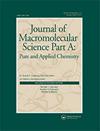The effect of cross-linking system and reinforcement on the cross-linking reaction of peroxide vulcanized ethylene-propylene-diene terpolymer (EPDM) matrix
IF 2.4
3区 化学
Q3 POLYMER SCIENCE
Journal of Macromolecular Science Part A-Pure and Applied Chemistry
Pub Date : 2023-10-09
DOI:10.1080/10601325.2023.2265974
引用次数: 0
Abstract
AbstractIn this work, the effect of using of dicumyl-peroxide (DCP) (2, 5 & 8 phr) and co-agent triallyl-cyanurate (TAC) (2, 4 & 6 phr) as cross-linking system as well as multi-walled carbon nanotubes (MWCNTs) (5, 8 και 10 phr) as a filler, for ethylene-propylene-diene terpolymer (EPDM) was investigated. Differential scanning calorimetry (DSC) was employed in order to study the progress of the cross-linking reaction, based on the exothermic vulcanization peaks of isothermal (at 160, 170, 180, 190 °C) and non-isothermal experiments (with heating rates 5, 10, 25, 50 °C min−1). The autocatalytic model was successfully applied to the results of isothermal experiments and the activation energy (Ea) of the reaction was calculated, based on the Arrhenius equation. The Ozawa-Kissinger equations were also applied to the data obtained from the non-isothermal study. From the results obtained from isothermal DSC experiments, an increase was observed in the reaction rates accompanied with a decrease in Ea with the increase of DCP content, whereas a proportional relationship between TAC content and the enthalpy and Ea of the reaction was recorded. The incorporation of MWCNT’s in EPDM increased its Ea. From the non-isothermal DSC experiments, a significant increase in the enthalpy and Ea of the cross-linking reaction was observed at higher DCP content, whereas TAC content did not show any notable effect on the reaction. Based on the results of this research, it is concluded that the increase of peroxide content facilitates the vulcanization of EPDM, whereas inhibition was observed by the incorporation of MWCNT’s.Keywords: EPDM elastomerperoxideco-agentcarbon nanotubesvulcanizationdifferential scanning calorimetry AcknowledgmentsSpecial thanks go to Dr. Dimitrios Korres for his assistance in DSC experiments.Disclosure statementNo potential conflict of interest was reported by the authors.研究了交联体系和增强剂对过氧化物硫化三元共聚物(EPDM)基体交联反应的影响
摘要本文研究了过氧化二氨基(DCP)(2,5和8 phr)和助剂三烯丙基氰脲酸酯(TAC)(2,4和6 phr)作为交联体系,以及多壁碳纳米管(MWCNTs) (5,8 και 10 phr)作为填料对乙烯-丙烯-二烯三元共聚物(EPDM)的交联效果。根据等温(160、170、180、190℃)和非等温实验(升温速率为5、10、25、50℃min - 1)的放热硫化峰,采用差示扫描量热法(DSC)研究交联反应的进展。将自催化模型应用于等温实验结果,并根据Arrhenius方程计算了反应的活化能(Ea)。小泽-基辛格方程也适用于从非等温研究得到的数据。等温DSC实验结果表明,随着DCP含量的增加,反应速率增加,Ea降低,TAC含量与反应焓和Ea成正比关系。在非等温DSC实验中,高DCP含量显著增加了交联反应的焓和Ea,而TAC含量对交联反应的影响不显著。研究结果表明,过氧化氢含量的增加促进了EPDM的硫化,而MWCNT的加入则抑制了EPDM的硫化。关键词:三元乙丙橡胶弹性体过氧化物生态剂碳纳米管硫化差示扫描量热法致谢特别感谢Dimitrios Korres博士在DSC实验中的帮助。披露声明作者未报告潜在的利益冲突。
本文章由计算机程序翻译,如有差异,请以英文原文为准。
求助全文
约1分钟内获得全文
求助全文
来源期刊
CiteScore
4.60
自引率
16.00%
发文量
61
审稿时长
3.1 months
期刊介绍:
Journal of Macromolecular Science, Part A: Pure and Applied Chemistry (JMS-PAC) is a necessary resource for academic and industrial scientists and engineers whose interests center on both synthetic and naturally occurring polymers and their applications.

 求助内容:
求助内容: 应助结果提醒方式:
应助结果提醒方式:


